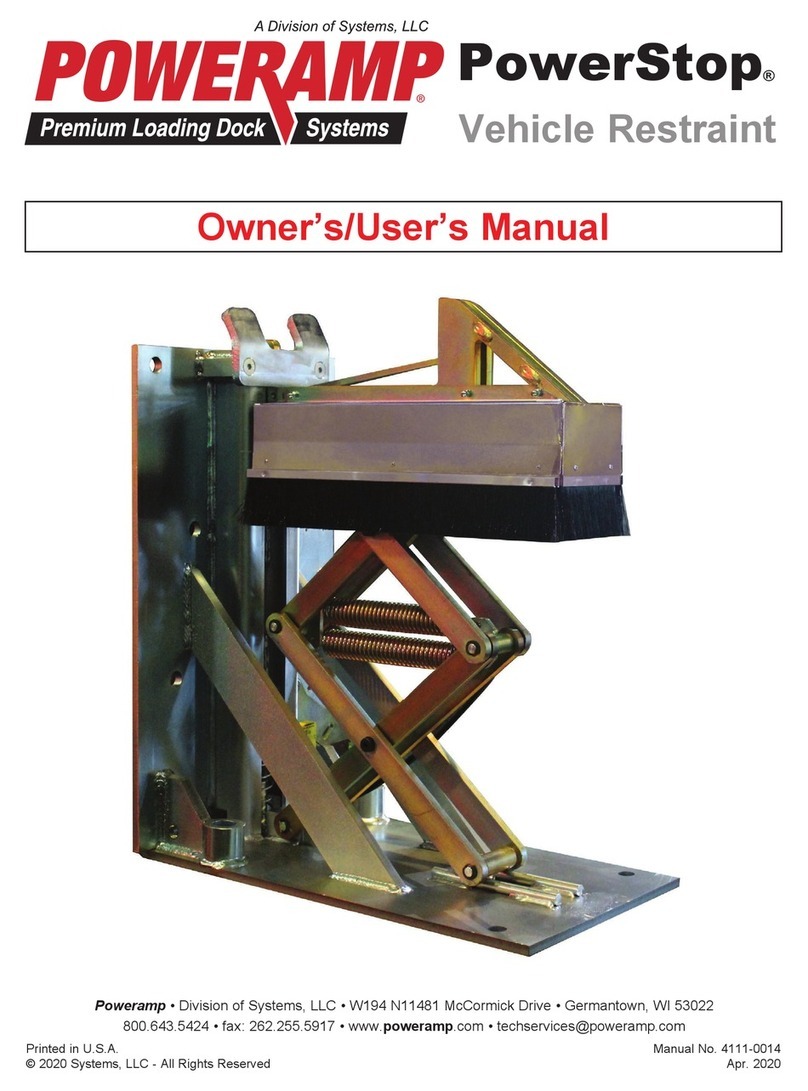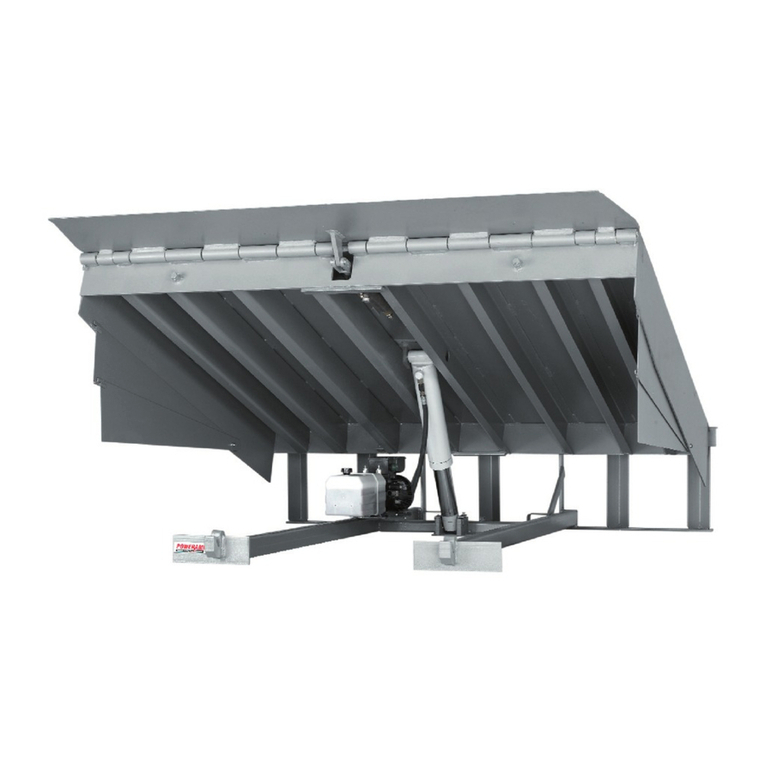
44111-0024 — Apr. 2020
©2020 Systems, LLC
Safety Decals
PRECAUTIONS
2
3
4
5
6
1
1
2
7
8
2
1
9
8
PROUDLY
MADEIN USA
SYSTEMS, INC .
GERMANTOWN, WI
MALVERN, AR
9
.
CRUSH HAZARD
Before doing any maintenance, repair or adjustments on the dock
leveler, rst store the leveler in a vertical position with lip extended,
then ensure all maintenance props are in maintenance positions
and properly secured, and then properly secure the storage prop
with the prop lock pin.
DO NOT remove the prop lock pin from the storage prop until you
are sure the hydraulic system is in proper working condition and all
maintenance props are in maintenance positions and properly
secured. After prop lock pin is removed from the storage prop all
maintenance props may be returned to storage positions. DO NOT
stand in front of the dock leveler. Reach from side of the leveler.
DO NOT force the prop lock pin out of the storage prop. If the pin
does not slide freely, support the leveler securely using other means
and determine the cause of the interference.
Failure to follow these instruction will result in death or serious
injury.
Refer to owner’s/user’s manual for proper procedure.
1751-0130 Rev D
.
CRUSH HAZARD
Before doing any maintenance, repair or adjustments on the dock
leveler, rst store the leveler in a vertical position with lip extended,
then ensure all maintenance props are in maintenance positions
and properly secured, and then properly secure the storage prop
with the prop lock pin.
DO NOT remove the prop lock pin from the storage prop until you
are sure the hydraulic system is in proper working condition and all
maintenance props are in maintenance positions and properly
secured. After prop lock pin is removed from the storage prop all
maintenance props may be returned to storage positions. DO NOT
stand in front of the dock leveler. Reach from side of the leveler.
DO NOT force the prop lock pin out of the storage prop. If the pin
does not slide freely, support the leveler securely using other means
and determine the cause of the interference.
Failure to follow these instruction will result in death or serious
injury.
Refer to owner’s/user’s manual for proper procedure.
1751-0130 Rev D
4
6
CRUSH HAZARD
DO NOT REMOVE hydraulic cylinder until leveler is
safely supported by maintenance prop. Refer to
owner’s/user’s manual for proper maintenance
procedure. Failure to comply will result in death or
serious injury. 1751-0138 Rev B
5
ATTENTION INSTALLER:
Replace rear plug with
breather cap
Do not overfill
Oil should fill ½ site glass
Use ULTRA VIS HVI 15 or
MIL SPEC 5606
Questions Call: 800.643.5424
1751-0490 Rev B
Serial Tag
Left
Outside
Beam
Right
Outside
Beam
Decal 2 with have two positions, one on the left outside beam as shown and one on the right outside beam in the same position
Decal 8 will have two positions, one on the left outside beam as shown and one on the right outside beam in the same position
Decal 10 with have two positions, one on the left outside beam as shown and one on the right outside beam in the same position
Decal 3 will be positioned on the upper most corner of the right outside beam (mirror position of decal 7)
CRUSH HAZARD
DO NOT WALK IN
FRONT OF DOCK
LEVELER until you:
Restore the dock
leveler to its safe
stored vertical
position with lip
extended.
Unsupported dock
levelers can lower
unexpectedly.
Before allowing
vehicle to leave the
dock always:
Ensure that no equipment material or
people are on dock leveler.
Restore dock leveler to its safe stored vertical
position with lip extended.
OPERATION
1. Read and follow all instructions and warnings in the
owner’s/user’s manual.
2. Use of dock leveler restricted to authorized personnel.
3. Always chock transport vehicle wheels or engage vehicle
restraint before operating dock leveler or beginning to
load or unload.
4. Never use hands or equipment to move the ramp or lip.
5. Before activating dock leveler:
Ensure transport vehicle is backed in against bumpers.
Remove any end loads if required.
Check transport vehicle alignment to avoid lip
interference. If lip does not lower to transport vehicle
bed, reposition transport vehicle.
6. Ensure that transport vehicle bed supports extended lip
or the leveler frame supports the ramp before driving on
ramp.
7. Stay clear of hinges and front and sides of moving dock
leveler.
8. Never use damaged or malfunctioning dock leveler.
Report problems immediately to supervisor.
MAINTENANCE/SERVICE
1. Read and follow all instructions, warnings and
maintenance schedules in the owner’s/user’s manual.
2. Maintenance/service of dock leveler restricted to
authorized personnel.
3. Place barriers on the driveway and on dock oor to
indicate service work is being performed.
4. DO NOT SERVICE LEVELER unless dock leveler is securely
supported by all prop.
a. First, ensure all maintenance props are in maintenance
positions and properly secured.
b. Then engage prop lock pin in storage prop.
5. Turn o power and use OSHA lockout/tagout procedures.
Failure to follow posted instructions
will result in death or serious injury.
Call 1.800.643.5424 for replacement placards, warning labels, or owner’s/user’smanuals
SAFETY INFORMATION
CRUSH HAZARD
DO NOT WALK IN
FRONT OF DOCK
LEVELER until you:
Restore the dock
leveler to its safe
stored vertical
position with lip
extended.
Unsupported dock
levelers can lower
unexpectedly.
Before allowing
vehicle to leave the
dock always:
Ensure that no equipment material or
people are on dock leveler.
Restore dock leveler to its safe stored vertical
position with lip extended.
OPERATION
1. Read and follow all instructions and warnings in the
owner’s/user’s manual.
2. Use of dock leveler restricted to authorized personnel.
3. Always chock transport vehicle wheels or engage vehicle
restraint before operating dock leveler or beginning to
load or unload.
4. Never use hands or equipment to move the ramp or lip.
5. Before activating dock leveler:
Ensure transport vehicle is backed in against bumpers.
Remove any end loads if required.
Check transport vehicle alignment to avoid lip
interference. If lip does not lower to transport vehicle
bed, reposition transport vehicle.
6. Ensure that transport vehicle bed supports extended lip
or the leveler frame supports the ramp before driving on
ramp.
7. Stay clear of hinges and front and sides of moving dock
leveler.
8. Never use damaged or malfunctioning dock leveler.
Report problems immediately to supervisor.
MAINTENANCE/SERVICE
1. Read and follow all instructions, warnings and
maintenance schedules in the owner’s/user’s manual.
2. Maintenance/service of dock leveler restricted to
authorized personnel.
3. Place barriers on the driveway and on dock oor to
indicate service work is being performed.
4. DO NOT SERVICE LEVELER unless dock leveler is securely
supported by all prop.
a. First, ensure all maintenance props are in maintenance
positions and properly secured.
b. Then engage prop lock pin in storage prop.
5. Turn o power and use OSHA lockout/tagout procedures.
Failure to follow posted instructions
will result in death or serious injury.
Call 1.800.643.5424 for replacement placards, warning labels, or owner’s/user’smanuals
SAFETY INFORMATION
10
10
8
8
1
2
PROP IS FOR MAINTENANCE USE ONLY.
Operate leveler ONLY when maintenance prop is in the
stored position with the top of the maintenance prop
raised to the line indicated below, and bolt is fully
threaded in the upper hole.
1751-1287
PROP IS FOR MAINTENANCE USE ONLY.
Operate leveler ONLY when maintenance prop is in the
stored position with the top of the maintenance prop
raised to the line indicated below, and bolt is fully
threaded in the upper hole.
1751-1287
10
FIG.“A ”
CRUSH HAZARD
DO NOT WORK UNDER OR IN FRONT OF
DOCK LEVELER unless ALL props have been
properly positioned and secured. First, back out
bolt to position side maintenance prop(s) as shown
in figure “A” below. Then position storage prop and
secure with prop lock pin as shown in figure “B”
below. Failure to do so will result in death or
serious injury. Refer to owner’s/user’s manual for
proper procedure.
Prop Lock
Pin
Storage
Prop
Stored
Position
Maintenance
Position
Bolt
Maintenance
Prop
1751-1293
FIG.“B”
FIG.“A ”
CRUSH HAZARD
DO NOT WORK UNDER OR IN FRONT OF
DOCK LEVELER unless ALL props have been
properly positioned and secured. First, back out
bolt to position side maintenance prop(s) as shown
in figure “A” below. Then position storage prop and
secure with prop lock pin as shown in figure “B”
below. Failure to do so will result in death or
serious injury. Refer to owner’s/user’s manual for
proper procedure.
Prop Lock
Pin
Storage
Prop
Stored
Position
Maintenance
Position
Bolt
Maintenance
Prop
1751-1293
FIG.“B”
3
moc..www cnIsmetsySkcoD
4245.346.008.1
7
VSHSERIES
4245.346.008.1moc.cnIsmetsySkcoD.www
TM





























